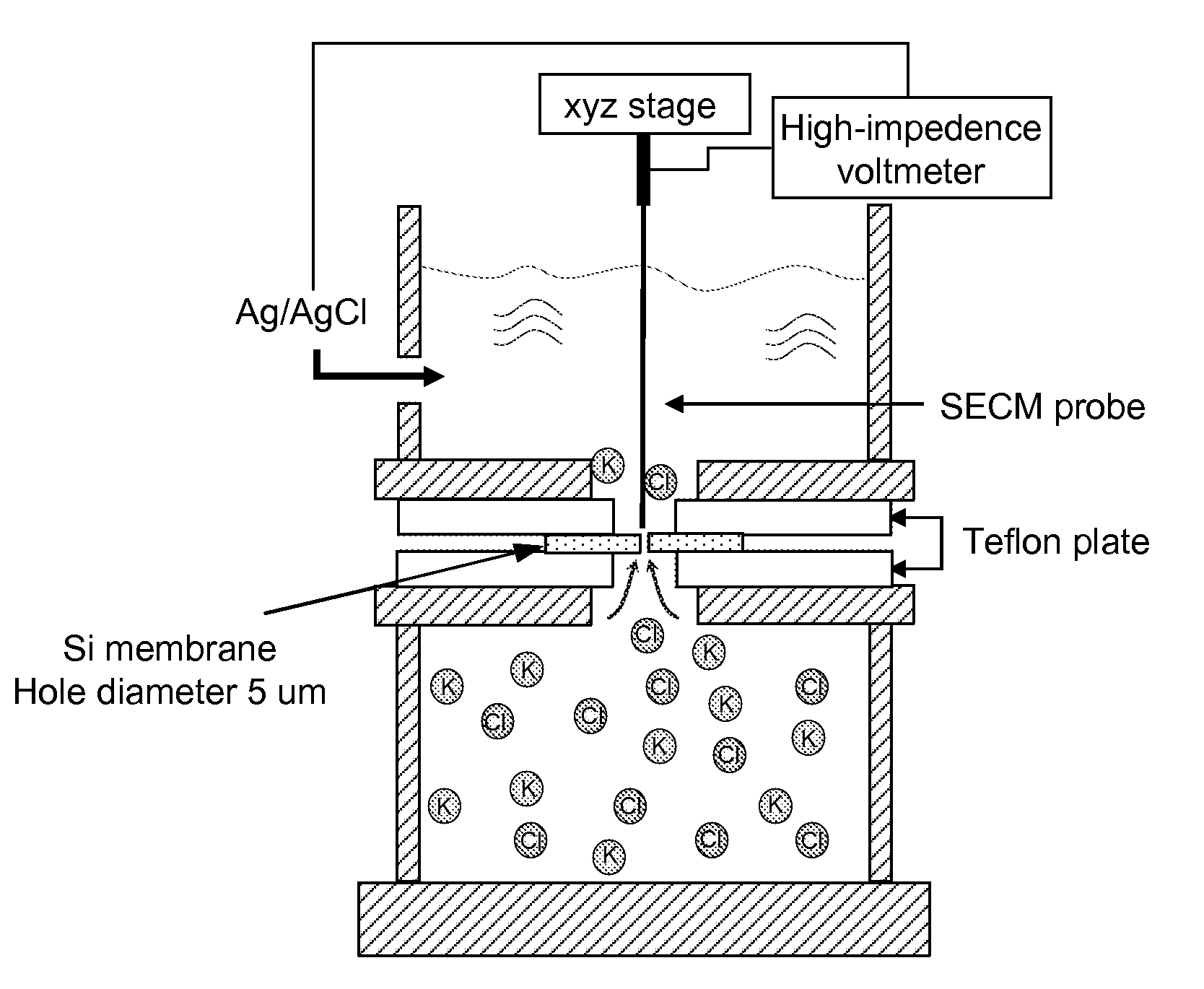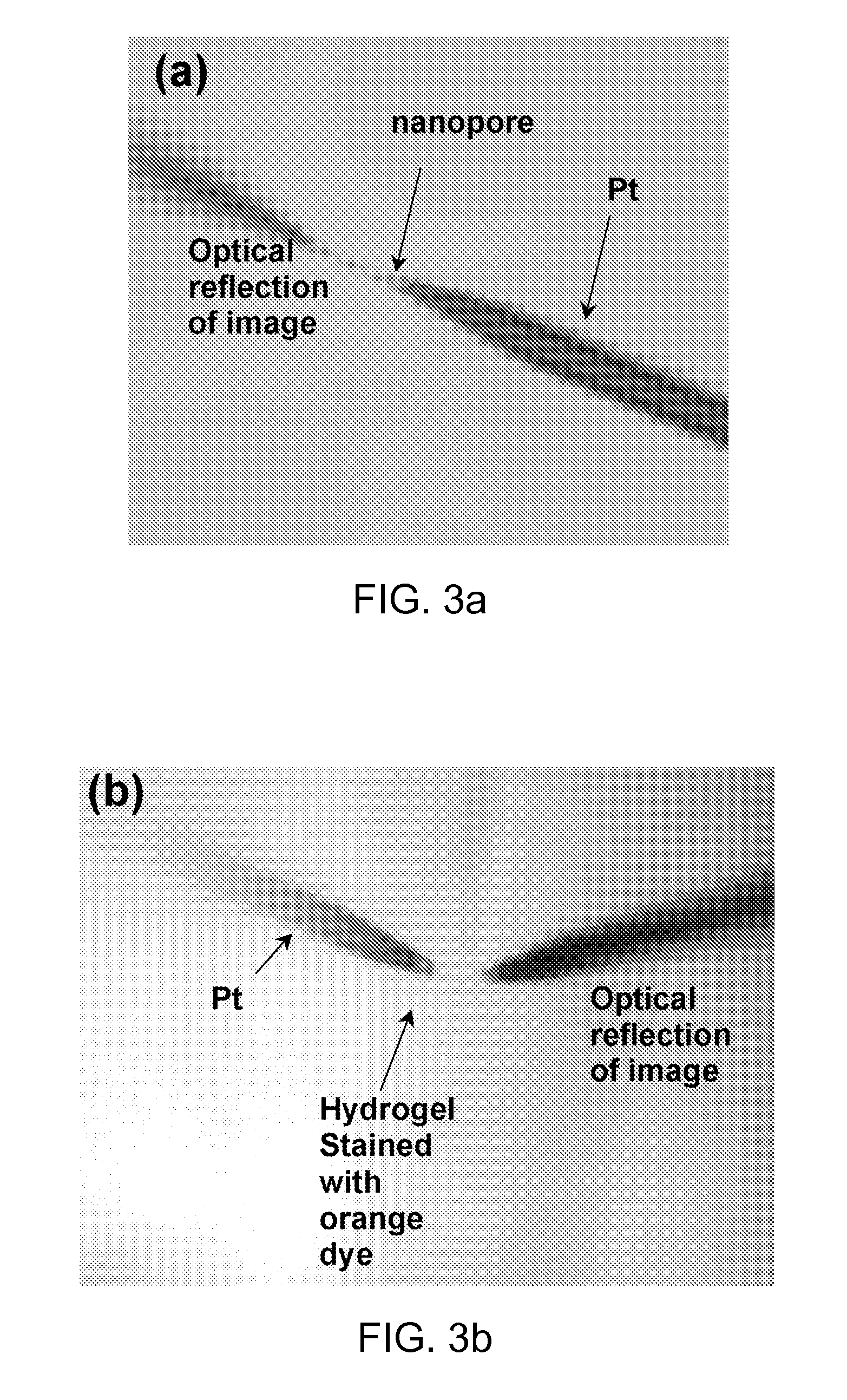Nanopore based ion-selective electrodes
a technology of ionselective electrodes and nanopores, applied in the field of nanotechnology, can solve the problems of inability to stabilize the affixed layer on a small electrode area, and the limited application of potentiometric umes for secm studies
- Summary
- Abstract
- Description
- Claims
- Application Information
AI Technical Summary
Benefits of technology
Problems solved by technology
Method used
Image
Examples
example 1
Overview of the Fabrication of Nanopore Electrode
[0052]The fabrication of glass nanopore electrodes begins when a Pt wire with a sharpened tip was sealed in a soda lime glass capillary, and the glass was polished to expose a Pt nanodisk electrode. The exposed Pt surface was then electrochemically etched in a 1.2 M CaCl2 solution to create a conical pore within the glass, with a Pt microdisk embedded at the bottom of the pore. The radius of the orifice of the nanopore electrodes prepared as described here was normally less than 1.0 μpm. The final structure of the electrode is schematically depicted in FIGS. 1 and 2a.
example 2
Deposition of IrO2 Film in the Glass Nanopore Electrode
[0053]Electrodeposition of iridium oxide film on a nanopore electrode was performed by cycling the applied potentials from 1.2 V to −0.85 V (vs. Ag / AgCl) one to three times at a scan rate of 100 mV / s in a fresh deposition solution. The deposition solution was prepared as follows. A 75 mg of IrCl4 was dissolved in 50 mL of water, and magnetically stirred for 30 min. A 0.5 mL aliquot of 30% hydrogen peroxide solution was added and stirred for 10 min. A 250 mg of oxalic acid dehydrate was added and the solution was stirred again for 10 more min. The pH of the solution was adjusted slowly to 10.5 by adding small portions of anhydrous potassium carbonate. The resulting yellow solution was covered and left at room temperature for 2 days for stabilization. About 2 mL of fresh deposition solution was used for the preparation of each electrode. Once the deposition is complete, the nanopore electrode tip was washed with distilled water an...
example 3
Deposition of Ag / AgCl Film in the Glass Nanopore Electrode
[0054]The electrodeposition of Ag at the Pt electrode in the nanopore was performed by cycling the applied potential from 0.0 V to −0.15 V (vs. Ag / AgCl) once at the scan rate of 1.0 mV / s in a fresh deposition solution. The deposition solution was prepared to contain 0.1 M AgNO3, 0.2 M EDTA, 0.5 M NH4OH, and 0.1 M NH4NO3. Once the deposition is complete, the nanopore electrode is washed with distilled water and air dried. The AgCl layer was formed by chloridating the electrodeposited Ag surface with a 3 M FeCl3 solution for 30 min. The final structure of the electrode is schematically depicted in FIG. 2b.
PUM
| Property | Measurement | Unit |
|---|---|---|
| diameter | aaaaa | aaaaa |
| diameter | aaaaa | aaaaa |
| diameter | aaaaa | aaaaa |
Abstract
Description
Claims
Application Information
 Login to View More
Login to View More - R&D
- Intellectual Property
- Life Sciences
- Materials
- Tech Scout
- Unparalleled Data Quality
- Higher Quality Content
- 60% Fewer Hallucinations
Browse by: Latest US Patents, China's latest patents, Technical Efficacy Thesaurus, Application Domain, Technology Topic, Popular Technical Reports.
© 2025 PatSnap. All rights reserved.Legal|Privacy policy|Modern Slavery Act Transparency Statement|Sitemap|About US| Contact US: help@patsnap.com



